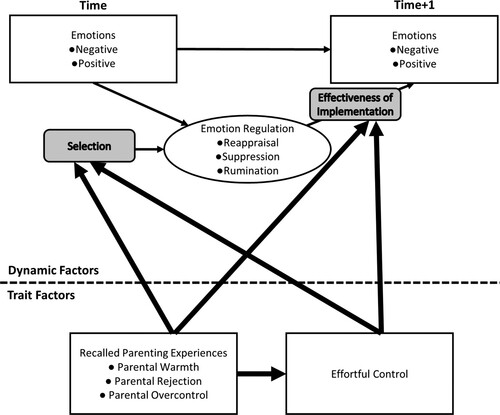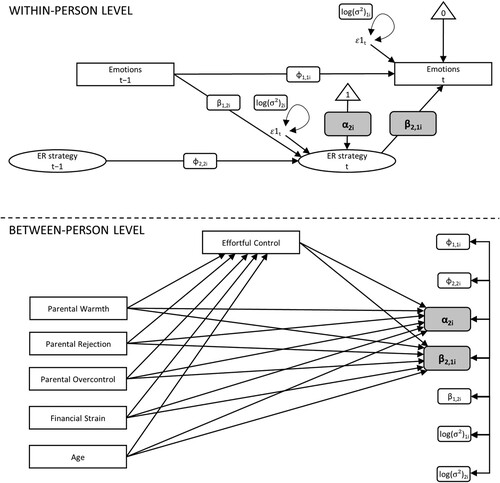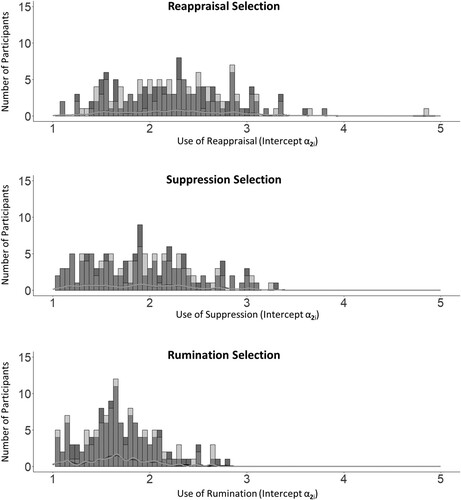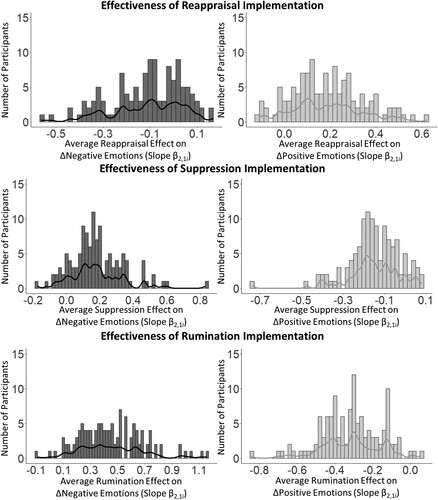Figures & data
Figure 1. Conceptual model regarding roles of recalled parenting experiences and effortful control in adult daily selection and implementation of emotion regulation.

Figure 2. Dynamic structural equation model for effects of recalled parenting experiences and effortful control on selection of emotion regulation and effectiveness of its implementation.
Notes. The bolded α2i and β2,1i parameters with grey background refer to the main outcome variables of random intercept of the ER strategy (i.e., selection) and the random cross-lagged slope of the ER strategy on emotions (i.e., the effectiveness of implementation), respectively. It should be noted that the effect of each between-level predictor on the random cross-lagged slope can also be interpreted as the cross-level interaction of the predictor and ER strategy on emotions. The φi and log(σ²i) parameters refer to the random autoregressive slopes and residual variances, respectively. The residual variances were estimated using the log transformation to guarantee all individual variances to be positive, which is a standard approach in dynamic structural modelling. Emotions (i.e., within-level factor scores of negative and positive emotions) were handled as the within-level variables because they did not have between-level variance. Moreover, as the intercepts of emotions did not differ from zero, they were fixed to zero to simplify the models. All between-level predictors were grand-mean-centred. The secondary models for recalled fathering and mothering styles and effortful control subdimensions of activation, attention, and inhibitory control used the same structure. ER = emotion regulation.

Table 1. Correlations between study variables at between-person level for aggregated data.
Figure 3. Distributions for selection of emotion regulation strategies between participants.
Notes. The black- and grey-colour distributions present the Bayesian plausible value factor scores of participants' emotion regulation strategy intercepts (i.e., selection parameters) in the dynamic structural equation models for negative and positive emotions, respectively. As shown by the density plot lines (black and grey colour), the estimates were highly overlapping between the models. Five hundred imputations were used to estimate the factor scores.

Figure 4. Distributions for effectiveness of emotion regulation implementation between participants.
Notes. The distributions present the Bayesian plausible value factor scores of participants' emotion regulation strategy slopes on the change in the target emotions (i.e., implementation effectiveness parameters) in the dynamic structural equation models for negative (left column with black colour) and positive emotions (right column with grey colour). Five hundred imputations were used to estimate the factor scores.

Table 2. Unstandardised effects of recalled parenting experiences and effortful control on selection of reappraisal and effectiveness of its implementation.
Table 3. Unstandardised effects of recalled parenting experiences and effortful control on selection of suppression and effectiveness of its implementation.
Table 4. Unstandardised effects of recalled parenting experiences and effortful control on selection of rumination and effectiveness of its implementation.
Table 5. Unstandardised effects of recalled parenting experiences on effortful control.
Supplemental_Material_11.docx
Download MS Word (361.4 KB)Supplemental_Material_10.docx
Download MS Word (38.3 KB)Supplemental_Material_9.docx
Download MS Word (243.6 KB)Supplemental_Material_8.docx
Download MS Word (61.8 KB)Supplemental_Material_7.docx
Download MS Word (1.5 MB)Supplemental_Material_6.docx
Download MS Word (30.5 KB)Supplemental_Material_5.docx
Download MS Word (667.2 KB)Supplemental_Material_4.docx
Download MS Word (16 KB)Supplemental_Material_3.docx
Download MS Word (931.2 KB)Supplemental_Material_2.docx
Download MS Word (16.9 KB)Supplemental_Material_1.docx
Download MS Word (392.2 KB)Data availability statement
The data that support the findings of this study are openly available in https://doi.org/10.17605/OSF.IO/R93SW.
